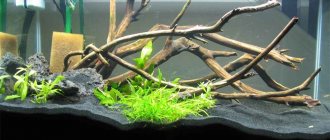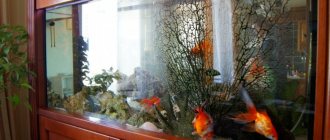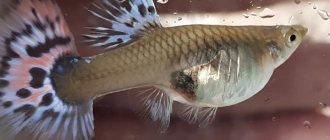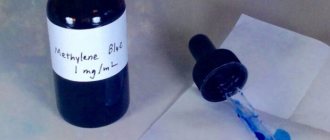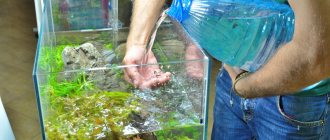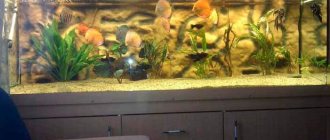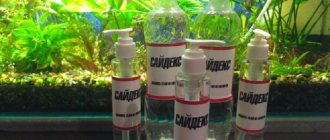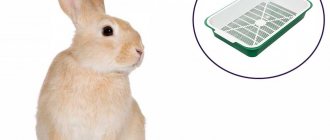Aquarium fish need clean water. It's a matter of survival. Waste products are released into the surrounding fluid. This makes it toxic. The fish breathe it again and receive a dose of toxic substances - ammonia, nitrates, nitrites. Over time, the concentration increases. The inhabitants of the aquarium get sick and die. The water looks clean. Therefore, it is necessary to regularly clean the aquarium and change its water.
Another reason is overgrowth. It is also associated with waste products, rotting food debris, and microorganisms. The glass becomes covered with dirt and algae. The water becomes cloudy. The filter becomes clogged and stops working. The life of the fish becomes unbearable.
How to clean an aquarium?
To do this you will need a certain set of tools. Detergents are used every few cleanings. In addition, you need clean, fresh water and a container where you can place the aquarium inhabitants and plants.
Aquarium cleaning tools
- First of all, you will need a net. They catch flora and fauna.
Interesting fact: a small net is easier to manipulate in the water, a larger one is easier to catch fish. The choice of net depends on personal convenience.
- To clean the walls you need a special scraper. Different materials require different scrapers; there are separate types for cleaning corners and stubborn dirt. You need a set of several scrapers or a universal tool with interchangeable attachments. This will allow you to achieve better cleanliness and ensure the prevention of various diseases.
- To clean the soil from waste, a siphon is needed. This is a specially designed container with a hose. The soil is scooped up with a siphon, water and waste flow down the hose, and heavier materials remain in place.
- A bucket, preferably several, is used in different ways. Dirty water is poured into it and clean water is poured out of it. You can put fish in it while cleaning. The bucket into which the aquarium is drained should be used only for this purpose, so that toxic substances do not get anywhere else.
Detergents
There is often advice to use bleach or “whiteness”.
Attention! It is prohibited to wash the aquarium itself with them! Getting even a small amount of such products into the water will kill all the fish. Bleach is used in exceptional cases and only for cleaning decorations.
A less dangerous analogue is hydrogen peroxide. The ideal solution is plain water. Only it definitely won’t harm the inhabitants. For particularly difficult stains, boiling water is used.
Baking soda, potassium permanganate, and washing powder solution are used to disinfect the tank.
It is acceptable to use chemical cleaners on the outer walls of the aquarium. The procedure should be performed carefully and carefully. Special napkins for glass and napkins for monitors are also suitable.
Necessary equipment
To properly clean an aquarium, you will need special tools. They can be purchased at a pet store. It is better not to use improvised materials: small particles of the sponges we are used to can be deadly for fish.
To clean your aquarium you will need the following:
- The scraper is a dense sponge attached to the handle using a metal frame. It is convenient for cleaning glass from plaque.
- A siphon allows you to remove debris from the ground.
- A net for catching and transplanting fish into another container. Prepare a large jar of settled water for them.
- A toothbrush is useful for cleaning filter parts or small decorative elements.
- Paper or regular towels will help quickly dry up excess moisture.
- An aquarium pump is a device that allows you to quickly pump out a large volume of water from an artificial reservoir.
Advice! Instead of a siphon or pump, you can use a piece of ordinary hose of small diameter.
What detergents can I use?
The aquarium should be cleaned only with special products. Ordinary household chemicals are, for the most part, harmless to humans, but destructive to the underwater world. To avoid disaster, purchase an aquarium cleaner from a pet store. If unforeseen circumstances occur and you have to use a soap solution, rinse the vessel with running water several times. But it is better to avoid such situations and not abuse chemicals.
Beginning aquarists are wondering whether it is permissible to clean the vessel with improvised means - salt or soda?
Some people use traditional methods quite successfully.
- Transfer the fish using a net into another vessel with settled water. Cover the container with a towel to prevent the fish from jumping out, frightened by the excessively bright light.
- Pour out the dirty liquid and rinse the walls with hot water, sprinkle the glass generously with soda and leave for 15 minutes. Sea salt works in a similar way.
- Rinse the fish house thoroughly under the tap to remove all the alkali.
- Rinse the aquarium with settled water prepared for filling.
- While the walls of the tank are wet, blot them with a paper towel and polish them.
How to properly clean an aquarium in a planned step-by-step manner
A routine cleaning of an aquarium involves several parts: cleaning the bottom, walls, decorations, filter (if necessary) and adding water. The aquarist’s movements should be smooth so as not to frighten the inhabitants.
Note! During scheduled cleaning, fish are not removed. This will cause more stress than cleaning. In addition, a sharp change in the composition of the water has a very bad effect on the health of fish.
The soil and bottom of the aquarium are cleaned last. As a result of previous actions, dirt and algae settle right there. Washing the soil removes debris and completes maintenance.
How to clean the walls of an aquarium
The walls are cleaned with special scrapers or a sponge without the use of cleaning agents. Particular attention must be paid to the corners. The type of tool depends on the material of the aquarium: glass is difficult to scratch, but for acrylic you will have to use the softest surface.
To begin with, the aquarist cleans the walls of the container from plaque. Next comes the turn of seams, corners and the ground area. If there is a lid, it is convenient to remove it and rinse the whole thing under running water.
It is usually enough to rinse the outer walls with warm water and wipe dry. A sponge will help with heavy dirt. Wipes for glass or monitors are safe and will eliminate streaks. You can use liquid to clean glass. If the aquarium does not have a lid, glass cleaners must be used carefully. The product is applied to half the walls, then distributed manually. Wipe the container with paper, newspaper without pictures, soft cloth, microfiber cloths.
Scenery
Stone and artificial plants are cleaned with running water and a sponge. For more severe stains, boiling water is used. Hydrogen peroxide and bleach are used only in extreme cases. Bleach must be diluted with water in a ratio of 1:9.
Important! After using cleaning products, rinse items thoroughly before placing them in the aquarium. Even a small amount of bleach will cause the death of all fish. Unwashed peroxide will disintegrate in water, but it will still not be beneficial for your pets.
Poor quality decorations can be damaged by bleach. Also, they cannot be used to process objects made of silk.
Only water is used to clean natural scenery. Some experts recommend not washing them at all. It’s really better not to even move snags and branches. The algae growing on them is often decorative and serves as food for some fish. Corals should not be moved either. But the stones need careful processing. If there is a lot of debris on the corals and branches, the problem is usually due to improper organization of the aquarium. Lack of space, too many fish, too much feeding - these are the things that need to be corrected first. If the tank becomes overgrown with algae too quickly, you need to fight the cause, not the effect.
Plant treatment
Many aquarium plants are easy to care for. They need to be cut and weeded. Trimming must be done regularly as algae grows quickly. Plants with long stems are most decorative from above, and timely pruning will preserve their appearance. Weeding is done carefully, without approaching the stem directly.
Some plants reproduce by layering. They will quickly fill the entire aquarium. If this scenario is undesirable, the cuttings should be removed at each scheduled cleaning.
Yellowed, fallen, rotting parts of algae must be removed. For these purposes it is convenient to use a narrow net.
Equipment
Timely cleaning of the filter is important for the well-being of the fish. The water pressure signals the need to do this. If it has become weaker, the device must be processed. It is clogged with food debris, algae and limescale.
The internal filter is the easiest to clean. You just need to rinse it under running water. Some people recommend using aquarium water for this so that the bacteria living on the filter do not die. However, these bacteria normally live in the soil. If the filter is washed with plain water, microorganisms will very quickly repopulate it. You will also need to clean the body of the device from algae and plaque.
You will have to clean the motor itself and its impeller somewhat less often. They are wiped with a clean dry cloth.
Be careful! Before disassembling the filter, disconnect it from the power supply.
Low-power filters in small aquariums must be treated with every scheduled cleaning. Stronger ones - every other time. Experts do not achieve perfect cleanliness when washing the filter. It will only harm the fish.
Some filter parts need to be replaced from time to time. There are disposable membranes that will have to be changed every week. Special sponges built into the device are replaced less frequently. If they are falling apart, it's time to buy new ones. The lifespan of the filter itself is also limited. At a certain point it stops being cleansed. You cannot treat it with detergents; you need to buy a new one.
The external filter is washed much less frequently. This is a more complex process. After disconnecting the device from the network, you must turn off the taps of the hoses, then separate the latter from the device. Next, the hoses, trays with filter filler, and the inside of the housing must be washed. This is convenient to do in the bath or shower. A narrow brush is suitable for hoses.
Afterwards the pallets must be placed back. Now comes the turn of the filter impeller. The housing is filled with water and the device is assembled. Hoses are connected. The aquarist then turns on the water supply and the electric current.
Important! When cleaning filters, do not use detergents! The smallest amount of cleaner will be distributed throughout the entire aquarium by the water flow. If the contamination is complex, hot water will help.
If the aquarium has a compressor, it also needs to be cleaned. Most often the hose becomes clogged. It can be cleaned or replaced. If the air filter is dirty, you will have to disassemble the device. You can wipe it from dust with a clean dry cloth.
The internal heating element is cleaned of algae. Usually you have to leave it on.
How to wash the soil in an aquarium
There is an opinion that aquarium soil must be cleaned by rinsing it with running water. Some beginners even heat it with boiling water. You can't do that. This will kill all beneficial microorganisms, disrupt the nitrogen balance in the aquarium and can lead to fish disease. Using a siphon is the correct way to clean.
Washing the soil too frequently should be avoided. This also has a negative effect on the fish. Cleaning once every two times will be sufficient.
How to clean the bottom of an aquarium
If there is no soil in the aquarium, the bottom is cleaned with a scraper. After which the waste layer is removed with a siphon.
Cleaning and adding water to the aquarium
Water change volumes are from 10% to 50% at a time. The frequency of water changes also varies. The water cannot be completely drained. Tap water won't work either. It contains too much chlorine. To purify water, it must be left for a day. Or you need to use special products such as air conditioners. Vitamins and mineral supplements will tailor the water exactly to the desired fish. Aquarium salt is used to obtain sea water.
Attention! If the water is cloudy, changing it completely can only make it worse.
If the liquid has deteriorated after adding fish or changing the water, it is usually enough to wait a few days. The sediment will settle to the bottom. If fresh water has not been added, the following options are possible:
- The filter has deteriorated or become dirty. It needs to be replaced or cleaned.
- Burrowing fish can lift a lot of soil from the bottom. They need a more powerful filter.
- The aquarium is overcrowded. You will have to put some of the fish in another container.
- Insufficient quality or too infrequent cleaning of the aquarium.
- Driftwood and branches release tannins when placed in water. They color the liquid and are liked by many fish. After some time, the tank will be clean again.
- Poor quality decorations are used. Poor quality varnish or paint can leach into the water, changing its color and poisoning the inhabitants. Such items must be removed immediately.
Cleaning frequency
It is recommended to clean an aquarium with a volume of more than 200 liters at least twice a month. Less than once a week. The frequency of general cleaning is determined individually. The following factors influence the decision:
- well-being of fish;
- number of inhabitants: the more populated the aquarium, the more often cleaning is needed;
- indicators of tests that determine the amount of nitrates in water (Ptero, NILPA and others);
- appearance of the aquarium;
- the smell coming from it.
Cleaning is necessary if the following occurs:
- brownish-greenish coating, fouling of walls and decor with algae;
- dirt rising from the bottom;
- deterioration of the filter (poorly pumps water);
- formation of a film on the surface;
- Poor breathing in fish and their death.
How to deep clean an aquarium with restart
Every aquarium needs a restart from time to time. It should not be carried out for prevention. Restarting an aquarium differs from the first start in that it is necessary to first sanitize the container and its contents.
Fish jigging
If the quality of the old aquarium water is sufficient, it is poured into a new container. The fish are transplanted there. Or use water that has been standing for at least two hours.
Important! You need to carefully monitor the behavior of the fish. Stress and changing conditions can cause illness or death.
Removing and washing plants and equipment
Living plants are washed with warm water and placed in a separate container. Filters and compressors are removed and thoroughly washed.
How to clean soil and decorations in an aquarium
To clean decorations in extreme conditions, it is acceptable to use bleach. Things must then be washed thoroughly. It is advisable to use boiling water. The soil is either replaced or processed. Processing consists of thoroughly washing the soil and calcining it in the oven.
Preparing and filling water
Water is prepared in the same way as during scheduled topping up. It is necessary to remember the concentration of various substances and compliance with PH, hardness and salinity.
Putting everything back in place
Starting the aquarium is carried out in the following order:
- Soil is laid out at the bottom.
- Suitable water is poured into the aquarium. The liquid level exceeds the ground level by about 10 cm.
- Plants and decor are placed.
- Equipment is being installed.
- Residents are starting.
- The water level is brought to the usual level in several steps.
- The equipment turns on.
The behavior of the fish must be carefully monitored at first.
Procedure for cleaning algae and decorative elements
In order to make the aquarium unique and create comfortable conditions for its inhabitants, various decorations are used - shells, large stones, ships, houses, artificial algae. These items are also covered with algae and traces of fish activity, so they require regular cleaning.
To maintain order in the tank, periodically weed out live algae and remove damaged parts of plants
Procedure for cleaning the decorations:
- Remove items that require cleaning from the tank.
- Rinse items with warm running water.
- Use an old toothbrush and baking soda to remove plaque. It is important to thoroughly wash all surfaces, remove plaque and dirt.
- Rinse the decorations with clean water and place them in the tank.
It is strictly forbidden to use any detergents to wash the decorations. Even the slightest particle of chemicals that gets into the water can lead to poisoning and death of aquarium inhabitants.
Special cases of cleaning an aquarium
How to clean a large aquarium at home
Magnetic scrapers are available for cleaning deep aquariums. One part of the device is placed in the water, the other on the other side of the glass controls its movements. This allows you to clean hard-to-reach places. Your hands won't get wet. There is no point in pulling large decorations out of the water. It is enough to wipe with a sponge before treating the soil. Small ones can be reached with a manipulator. A hose is used to add water.
How to clean a small aquarium
The only difficulty here is soil treatment. For a small aquarium with a volume of 10-20 liters, the siphon is too large. It will drain half the water or more. You need to cut it in half and insert a small tap inside. You can buy one in the garden products section. You can also use any narrow tube. There are compact, low-power siphons on sale specifically for small aquariums.
How to clean an aquarium with fry
This aquarium lacks decorations and soil. However, a lot of dirt accumulates. The reservoir becomes covered with dirt and mucus. It is removed with a sponge. You need to take a small siphon.
Note! A siphon with a tube of standard width can suck in the fry. You can catch it with a net. It is preferable to use a tube for small aquariums.
How to properly clean an aquarium that hasn't been cleaned for a long time
If there are no fish in the aquarium, the tank is subjected to standard processing and restarting. If there are fish, they have adapted to live in dirty, toxic water. A sudden change of fluid to a more suitable one will kill them. The replacement is carried out gradually, no more than 10-15% at a time. When cleaning, it is important to stop in time. Fish that are not used to it will panic and may harm themselves. You shouldn't do everything at once. The most important thing is to clean the filters and soil.
How to clean an aquarium in emergency situations
In extreme situations, such as illness or death of fish, deep processing is required. Cleaning agents and boiling water are used. The soil and decorations should be changed, the equipment should be thoroughly cleaned. Living plants are planted in a separate container for a month or three. They are undergoing quarantine.
The aquarium itself needs to be filled with potassium permanganate or a solution of bleach or washing powder. Keep it like this for a day and rinse thoroughly.
Washing in an emergency in case of contamination and contamination of water
Restarting the aquarium is an emergency measure; it consists of a complete change of water, thorough cleaning of surfaces and complete or partial replacement of plants. This procedure is necessary if the aquarium is infected or the water in it is severely polluted. In the photo below you can see what heavy pollution looks like.
Inaction in such a situation will lead to diseases and death of fish, so as soon as possible it is necessary to temporarily relocate the inhabitants from the contaminated reservoir and carry out general cleaning.
The contaminated container is emptied completely and filled with disinfectants for a day. Bleach and potassium permanganate solution are best suited for these purposes.
All equipment removed from the aquarium is subjected to heat treatment (boiling), and after disinfection, the aquarium itself is thoroughly rinsed and left to dry for at least 24 hours.
The launch of the reservoir is carried out in several stages. After drying, add water, about a third of the maximum volume. Purified soil and artificial elements are placed inside. The container is left in this form for 5–7 days, and then the preserved algae are planted.
After another 3-5 days, add water and put the fish inside.
Tips for care and use.
How to prevent contamination so as not to wash the aquarium frequently
Maintenance must be carried out regularly. Cleaning too often and too hard will harm the fish, and too infrequently too. Cleaning products should only be used as a last resort. There should not be too many animals in the tank. There is no need to overfeed them. Equipment must be maintained in good condition. Part of the water is changed regularly. The soil should be siphoned, not washed. The main condition is attentive, but not excessive care.
How to clean the soil in an aquarium with a siphon
The end of the siphon hose must be directed into an empty bucket. Use the neck to scoop up the top layer of soil. The waste, along with some of the water, will fall into the bucket. You can't do this too carefully. It is enough to walk along the bottom once and remove what can be easily removed.
Attention! Some caution is required during the procedure. It can pull fish inside. This will not harm the small fish. It will go into a bucket where it will be easy to get out. But a large one, resisting the movement of water, can damage the fins. You should not point the siphon directly at the inhabitants of the aquarium.
If there are live plants in the tank, only the exposed areas need to be cleaned. If there are decorations and shelters, it is imperative to clean underneath them. This is where the most waste accumulates.
How to recognize aquarium pests and get rid of them
Any shellfish pose a threat to the aquarium, as they quickly pollute it. This is especially true for snails. They feed on fish food and actively reproduce. They can be removed by hand or using snail traps. These are sold in specialized stores.
Three types of algae pose a danger to an aquarium: brown, green and blue-green. To get rid of the first two, you need to adjust the tank lighting. Brown algae appears in dark water and looks like a brown coating. Greens multiply when there is too much light and make the water green and cloudy. If there are too many of them, residents can suffocate.
Attention! Algae reproduce only with sufficient food. Do not overfeed fish or keep many in one container. Timely cleaning is required.
Blue-green algae cover objects with a film. They are toxic to fish and steal light from plants. It's hard to get rid of them. The films are removed by hand or with a sponge, and the water is often replaced. Only restarting the aquarium is guaranteed to help.
If other algae appear in the aquarium, you can remove them physically.
Biological methods for cleaning an aquarium
Tetradons, loaches and Helena snails feed on other snails and clean the aquarium of them. Loricaria catfish eat rotting wood. Algae eaters and Amano shrimp will help get rid of algae.
We must remember that they are all living beings, just like other pets. They need to be looked after and their behavior monitored.
Cleaning an aquarium is a process that often intimidates beginners. There are many operations to be carried out and many parameters to be taken care of. Cleaning is slow at first, but over time it will take 30-40 minutes per week. A happy, healthy fish will please you much longer.
How often do you clean the aquarium, what equipment do you use? Write to us in the comments!
We clean it mechanically
To clean limescale and algae, you can use the following available tools:
- Kitchen sponge. This well-known dishwashing accessory effectively removes aquarium stains; all you need to do is walk the hard side on the inside of the glass and then the soft side to secure the result. It is impossible to damage the material from which the “fish house” is made with a sponge: when working manually, a person feels the force of pressure and pressure.
- An old plastic card (for example, a bank or discount card). An unnecessary household item turns out to be indispensable for cleaning up sediment. The thin edge of the card is very convenient for removing stuck dirt. In addition, the plastic acts delicately and does not scratch the glass.
- Toothbrush. The personal hygiene item copes well with dirt, penetrating into the most difficult to reach places. This type of cleaning is especially good for mini-aquariums and small decorative parts.
- Razor blade. It scrapes off heavy deposits well.
All these tools can be used without draining the water. After completing the work, there is no need to catch dirt from the surface. It is enough to drain some of the liquid using a siphon or hose (usually no more than 25% of the water is replaced), the rest will be drawn out by the filter. It will need to be removed, cleaned of mucus and plaque, then put back and added good water to the aquarium.
Helper fish
In addition to cleaning work carried out by humans, the condition of the aquarium is influenced by its inhabitants. It must be inhabited by fish, which also do cleaning. This is a very important point.
Orderlies
Pets can make a person's work easier. To do this, there must be the required number of them and, of course, they must be hardworking.
Before buying nursery fish, ask the seller as much as possible about the characteristics in order to choose the most suitable option.
gold fish
The bright resident of aquariums plays not only a decorative role. It is purchased specifically to maintain cleanliness in glass structures. Absorbs large food debris, making the bottom cleaner.
Viviparous inhabitants
Most representatives have a highly developed lower jaw, resembling a scraper. In this way, the fish remove plaque from the walls, surfaces of plants and soil. The most popular are mollies, guppies, swordtails and platies. Experienced fish farmers claim that fish survive without food. Filament serves as food.
Ancitrus
A cleaner fish that lives in aquariums with different volumes. The pet is small in size, so to clean a large aquarium you will need several fish. Ancitruses are distinguished by their hard work. Due to the structure of the suction cup, cleaning may not be as effective as you would like. An aquarium is a limited place in which it is not recommended to keep several males. Conflicts may arise. Because of this, fish can bite each other.
Brocade catfish
An ideal option for nurse fish for aquariums with a volume of 400 liters or more. This type of fish will not survive in small structures. In this case, the type of fish is replaced with another. Brocade catfish, if there are a couple of them, can easily clean a large aquarium of small unnecessary algae. Also suitable for this type of aquarium, such as a herbalist. The fish does the work with pleasure.
Labeo
Both green and two-color labeo cope with the cleaning task. It has a mouthparts that points downwards. They eat algae, but not as effectively as previous types of fish. After their work, not a trace of fouling remains. Labeos are not exclusively cleaners, rather it is their hobby. People who want to own fish should be aware of their main drawback - aggressiveness. They cannot tolerate other fish entering their territory.
Gourami
Small fish are quite shy and at the same time friendly. When any kind of danger is detected, they rush to hide in the algae. Gourami mainly lives in the upper and middle layers of water. The fish leads a diurnal lifestyle, constantly cleaning plants, removing various fouling.
Catfish otocinclus
They do the following:
- remove bacterial film;
- eat algae;
- eliminate organic matter that pollutes the aquarium.
Catfish clean stones, soil, aquarium walls, plant leaves and even driftwood at the bottom. They are unpretentious, which is a big plus.
Gyrinocheilus
The lips of aquarium inhabitants look like suction cups. There are folds on the inside of the lips. They resemble curves that imitate a grater. This structure helps the fish to act even in the most extreme situations. They not only scrape algae off the rocks.
They also cling to them with their lips, trying to hold on in a strong current.
When cleaning stones, they are not satisfied with such “food”. You have to work a lot. The fish does not eat filamentous algae, especially blackbeard.
See also
How to properly and quickly clean a shell and the best methods at home
Siamese algae eater
The representative of the water kingdom has many names. During its stay in the aquarium, it constantly fights algae. Effectively removes growths in the form of dark brushes on leaves, stones and other places. In addition to black beard, it eats green algae.
Remove fluff-shaped algae from any surface. Their mouthparts are best suited for this. A 100 liter aquarium will always be clean if you have 2 even the smallest algae eaters.
Snail
The most common types of snails found in home aquariums are:
- horned neretina;
- Neretina zebra;
- corbicula;
- turtle snail;
- ampularia;
- theodoxus;
- Helena.
Clams are not as successful in the role of orderlies, unlike fish. Despite this fact, they have their strengths. They easily destroy any kind of contamination - rotten plants, plaque and mucus on surfaces, film, food residues, remains of dead inhabitants and excrement of all inhabitants of the aquarium. You can understand the state of the aquatic world by their behavior. Certain actions serve as indicators of cleanliness. They have snails and a big minus. Their reproduction cannot be controlled, but it happens quickly and almost imperceptibly.
Shrimps
Small in size, they are called purity champions. The whole secret to a perfect aquarium is their body shape. Freshwater representatives have sharp fans. They act as a filter. The shoots are so thin that they can filter water. Thanks to such actions, feces and plant particles are extracted from the liquid. In exactly the same way, the food and what remains of the previous inhabitants of the aquarium are separated.
Males burrow deep into the ground, raising mud to the surface. They then clean the contaminated layer of water. At this time, females remove dirt from the bottom. Shrimp filter water well, but this is not the only thing they can boast of. In addition to purifying water, they effectively treat any surface. After their work, there will be no trace of fuzzy algae left. They do this job much better than fish.
